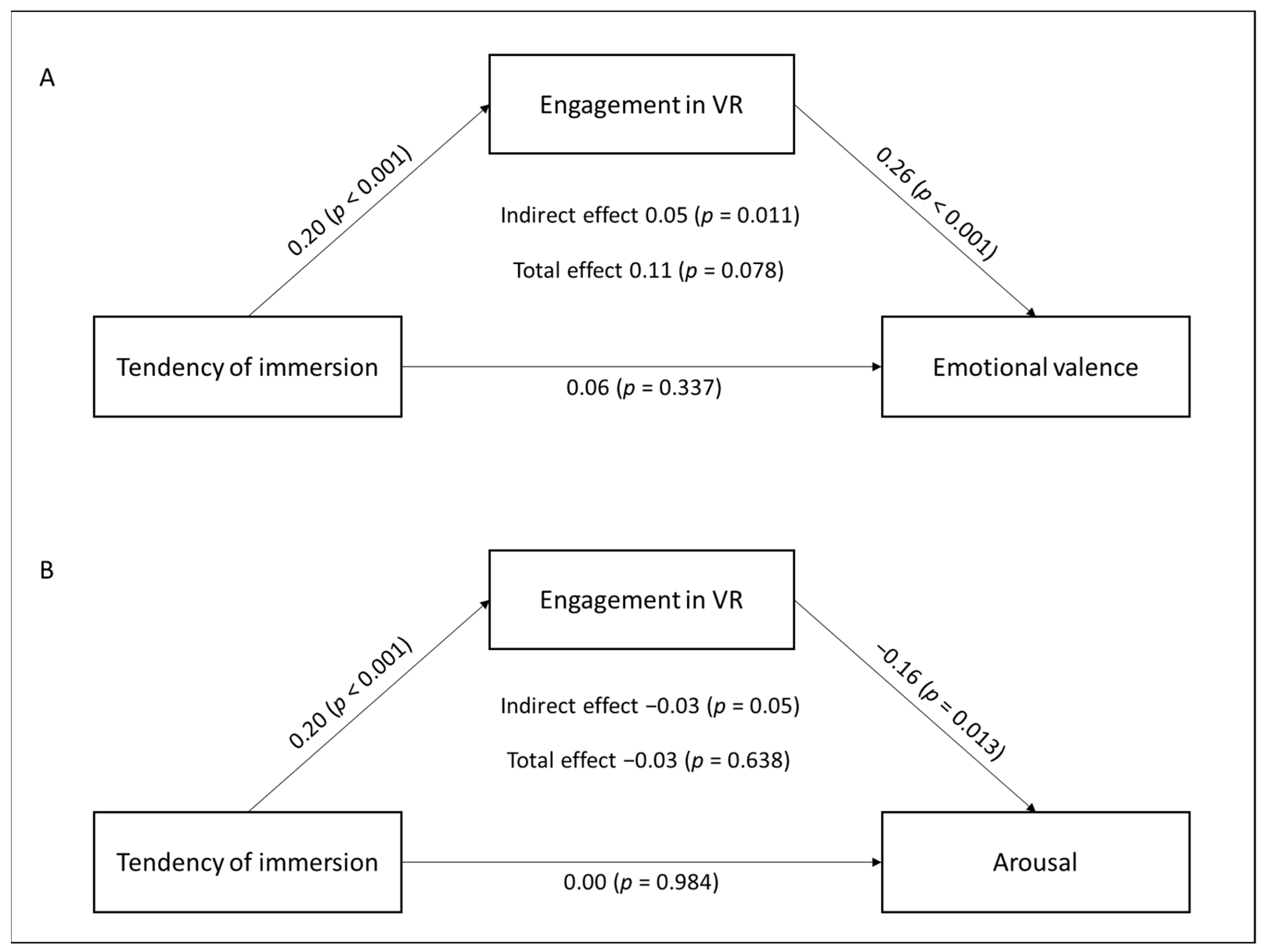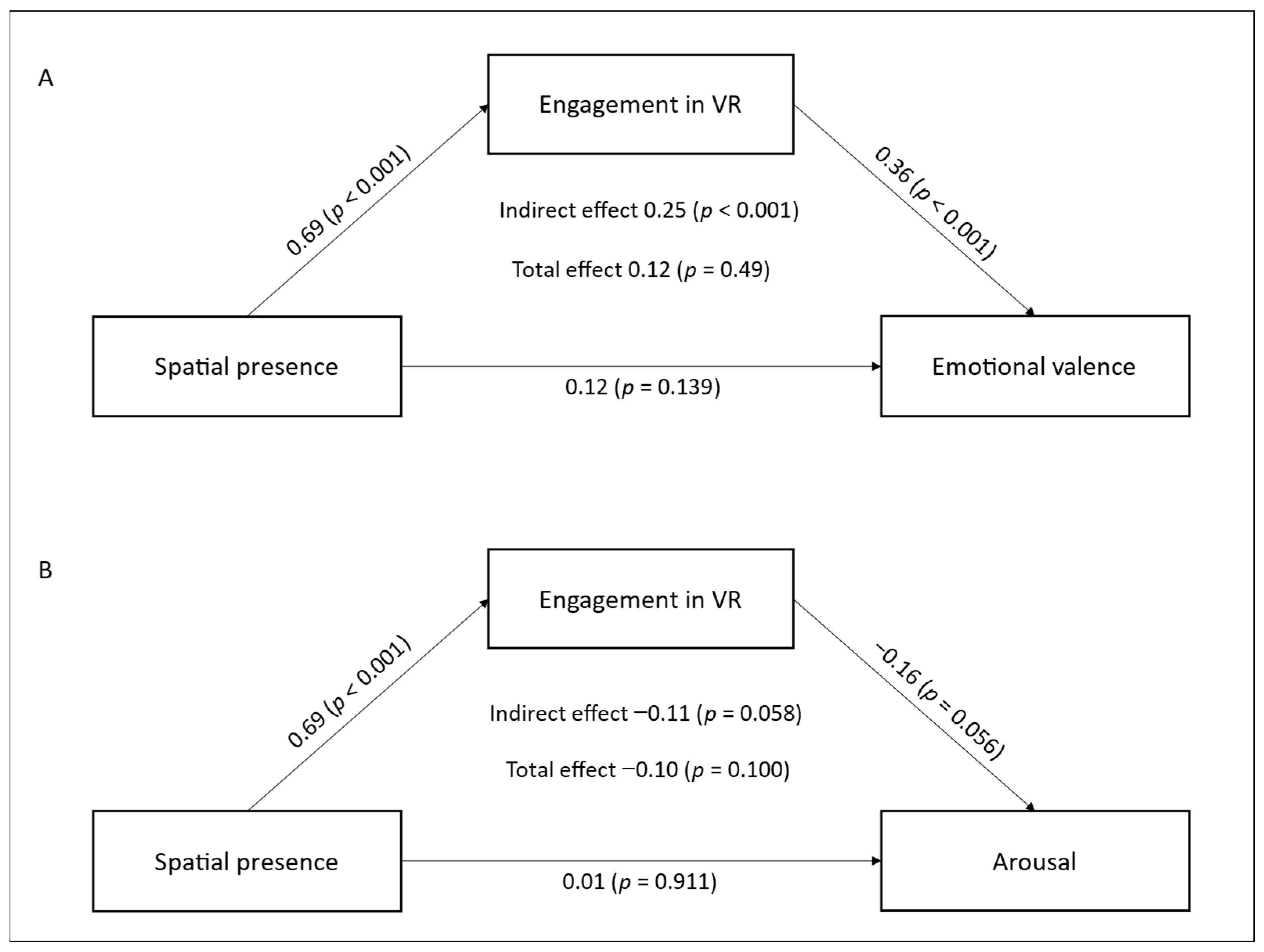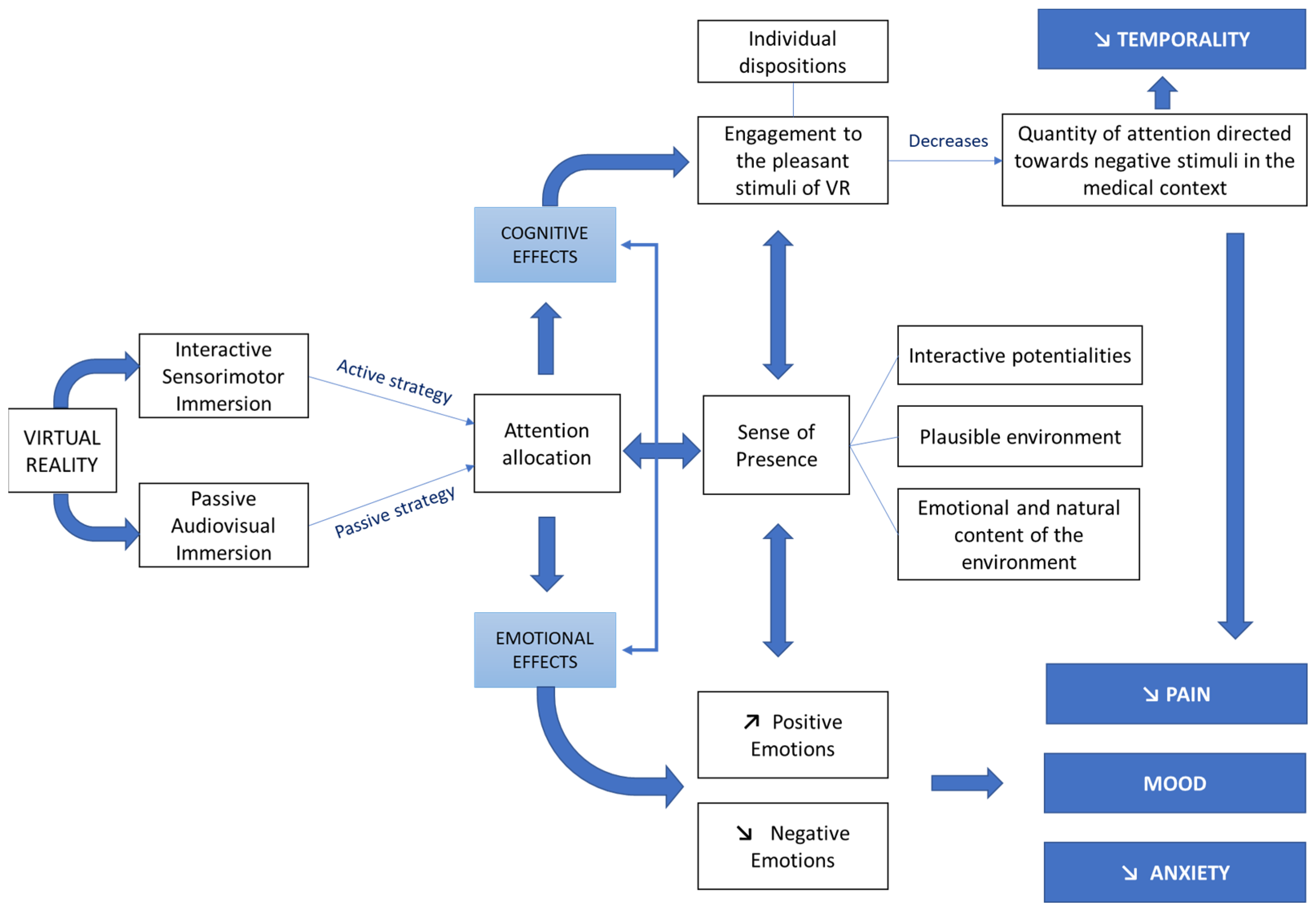The Role of Engagement in Virtual Reality to Enhance Emotional Well-Being in Breast Cancer Patients: A Mediation Analysis
Simple Summary
Abstract
1. Introduction
2. Materials and Methods
2.1. Sample
2.2. Materials
2.3. Statistical Analyses—Procedure
3. Results
3.1. Correlations
3.1.1. Capacity for Engagement and Immersion Engagement
3.1.2. Spatial Presence and Tendency of Immersion
3.2. Mediation
3.2.1. Impact of Tendency of Immersion via Engagement on Emotional Valence
3.2.2. Impact of Tendency of Immersion via Engagement on Arousal Level
3.2.3. Impact of Spatial Presence via Engagement on Emotional Valence
3.2.4. Impact of Spatial Presence via Engagement on Arousal
4. Discussion
4.1. Empirically Enriched Theoretical Model
4.2. Limitations
4.3. Perspectives
5. Conclusions
Author Contributions
Funding
Institutional Review Board Statement
Informed Consent Statement
Data Availability Statement
Conflicts of Interest
References
- Buche, H.; Michel, A.; Blanc, N. Use of virtual reality in oncology: From the state of the art to an integrative model. Front. Virtual Real. 2022, 3, 894162. [Google Scholar] [CrossRef]
- Mingqin, L.; Yuting, S.; Yushuo, N.; Ting, L.; Song, G.E.; Yaru, S.; Xin, W.; Ying, L.; Kuinan, L.; Xiuling, Y. Effectiveness of Virtual Reality in the Management of Anxiety and Pain Peri-Treatment for Breast Cancer: A Systematic Review and Meta-Analysis. J. Nurs. Res. 2024, 32, e343. [Google Scholar] [CrossRef]
- Sezgin, M.G.; Bektas, H. Research Trends and Highlights Toward Virtual Reality in Patients With Cancer: Bibliometric Analysis. CIN Comput. Inform. Nurs. 2024, 42, 80–86. [Google Scholar] [CrossRef]
- Pardini, S.; Gabrielli, S.; Dianti, M.; Novara, C.; Zucco, G.M.; Mich, O.; Forti, S. The role of personalization in the user experience, preferences and engagement with virtual reality environments for relaxation. Int. J. Environ. Res. Public Health 2022, 19, 7237. [Google Scholar] [CrossRef]
- Wang, Z.; Li, Y.; An, J.; Dong, W.; Li, H.; Ma, H.; Wang, J.; Wu, J.; Jiang, T.; Wang, G. Effects of restorative environment and presence on anxiety and depression based on interactive virtual reality scenarios. Int. J. Environ. Res. Public Health 2022, 19, 7878. [Google Scholar] [CrossRef]
- Buche, H.; Michel, A.; Piccoli, C.; Blanc, N. Contemplating or acting? Which immersive modes should be favored in virtual reality during physiotherapy for breast cancer rehabilitation. Front. Psychol. 2021, 12, 631186. [Google Scholar] [CrossRef] [PubMed]
- Buche, H.; Michel, A.; Blanc, N. When virtual reality supports patients’ emotional management in chemotherapy. Front. Virtual Real. 2023, 4, 1294482. [Google Scholar] [CrossRef]
- Sharma, A.; Sharma, N.; Chahal, A. Impact of Virtual Reality on Pain, ROM, Muscle Strength and Quality of Life among Breast Cancer Patients: An Integrative Review of Literature. Pain Manag. Nurs. Off. J. Am. Soc. Pain Manag. Nurses 2024, 25, 538–548. [Google Scholar] [CrossRef] [PubMed]
- Buche, H. Comprendre et Expliquer les Effets de la Réalité Virtuelle à Différentes Etapes de la Prise en Charge du Cancer du Sein: Apports Théoriques et Empiriques. Ph.D. Thesis, Université Paul Valéry Montpellier 3, Montpellier, France, 2024. [Google Scholar]
- Buche, H.; Michel, A.; Blanc, N. Using Virtual Reality During Chemotherapy to Support Emotional Regulation in Patients: Adding an Olfactory Reinforcement or not? (under review).
- Arane, K.; Behboudi, A.; Goldman, R.D. Virtual reality for pain and anxiety management in children. Can. Fam. Physician 2017, 63, 932–934. [Google Scholar] [PubMed]
- Chirico, A.; Maiorano, P.; Indovina, P.; Milanese, C.; Giordano, G.G.; Alivernini, F.; Iodice, G.; Gallo, L.; De Pietro, G.; Lucidi, F.; et al. Virtual reality and music therapy as distraction interventions to alleviate anxiety and improve mood states in breast cancer patients during chemotherapy. J. Cell. Physiol. 2020, 235, 5353–5362. [Google Scholar] [CrossRef]
- Lessiter, J.; Freeman, J.; Keogh, E.; Davidoff, J. A cross-media presence questionnaire: The ITC-sense of presence inventory. Presence Teleoperators Virtual Environ. 2001, 10, 282–297. [Google Scholar] [CrossRef]
- Garrett, B.M.; Tao, G.; Taverner, T.; Cordingley, E.; Sun, C. Patients perceptions of virtual reality therapy in the management of chronic cancer pain. Heliyon 2020, 6, e03916. [Google Scholar] [CrossRef]
- Burrai, F.; Sguanci, M.; Petrucci, G.; De Marinis, M.G.; Piredda, M. Effectiveness of immersive virtual reality on anxiety, fatigue and pain in patients with cancer undergoing chemotherapy: A systematic review and meta-analysis. Eur. J. Oncol. Nurs. Off. J. Eur. Oncol. Nurs. Soc. 2023, 64, 102340. [Google Scholar] [CrossRef]
- Ahmadpour, N.; Keep, M.; Janssen, A.; Rouf, A.S.; Marthick, M. Design strategies for virtual reality interventions for managing pain and anxiety in children and adolescents: Scoping review. JMIR Serious Games 2020, 8, e14565. [Google Scholar] [CrossRef]
- Erdős, S.; Horváth, K. The Impact of Virtual Reality (VR) on Psychological and Physiological Variables in Children Receiving Chemotherapy: A Pilot Cross-Over Study. Integr. Cancer Ther. 2023, 22, 15347354231168984. [Google Scholar] [CrossRef] [PubMed]
- Bouchard, S.; St-Jacques, J.; Robillard, G.; Renaud, P. Anxiety increases the feeling of presence in virtual reality. Presence Teleoperators Virtual Environ. 2008, 17, 376–391. [Google Scholar] [CrossRef]
- Baus, O.; Bouchard, S. Moving from virtual reality exposure-based therapy to augmented reality exposure-based therapy: A review. Front. Hum. Neurosci. 2014, 8, 112. [Google Scholar] [CrossRef] [PubMed]
- Slater, M.; Banakou, D.; Beacco, A.; Gallego, J.; Macia-Varela, F.; Oliva, R. A separate reality: An update on place illusion and plausibility in virtual reality. Front. Virtual Real. 2022, 3, 914392. [Google Scholar] [CrossRef]
- Brockmyer, J.H.; Fox, C.M.; Curtiss, K.A.; McBroom, E.; Burkhart, K.M.; Pidruzny, J.N. The development of the Game Engagement Questionnaire: A measure of engagement in video game-playing. J. Exp. Soc. Psychol. 2009, 45, 624–634. [Google Scholar] [CrossRef]
- Robillard, G.; Bouchard, S.; Renaud, P.; Cournoyer, L.G. Validation canadienne-française de deux mesures importantes en réalité virtuelle: L’Immersive Tendencies Questionnaire et le Presence Questionnaire. In Proceedings of the 25e Congrès Annuel de la Société Québécoise Pour la Recherche en Psychologie (SQRP), Trois-Rivières, QC, Canada, 1–3 November 2002. [Google Scholar]
- Wallach, H.S.; Safir, M.P.; Samana, R. Personality variables and presence. Virtual Real. 2010, 14, 3–13. [Google Scholar] [CrossRef]
- Kober, S.E.; Neuper, C. Personality and presence in virtual reality: Does their relationship depend on the used presence measure? Int. J. Humancomput. Interact. 2013, 29, 13–25. [Google Scholar] [CrossRef]
- Servotte, J.C.; Goosse, M.; Campbell, S.H.; Dardenne, N.; Pilote, B.; Simoneau, I.L.; Guillaume, M.; Bragard, I.; Ghuysen, A. Virtual reality experience: Immersion, sense of presence, and cybersickness. Clin. Simul. Nurs. 2020, 38, 35–43. [Google Scholar] [CrossRef]
- Hao, J.; Li, Y.; Swanson, R.; Chen, Z.; Siu, K.C. Effects of virtual reality on physical, cognitive, and psychological outcomes in cancer rehabilitation: A systematic review and meta-analysis. Support. Care Cancer 2023, 31, 112. [Google Scholar] [CrossRef] [PubMed]
- Helgeson, V.S.; Snyder, P.; Seltman, H. Psychological and physical adjustment to breast cancer over 4 years: Identifying distinct trajectories of change. Health Psychol. 2004, 23, 3. [Google Scholar] [CrossRef]
- Deshields, T.; Tibbs, T.; Fan, M.Y.; Taylor, M. Differences in patterns of depression after treatment for breast cancer. Psycho-Oncol. J. Psychol. Soc. Behav. Dimens. Cancer 2006, 15, 398–406. [Google Scholar] [CrossRef]
- Lam, W.W.; Bonanno, G.A.; Mancini, A.D.; Ho, S.; Chan, M.; Hung, W.K.; Or, A.; Fielding, R. Trajectories of psychological distress among Chinese women diagnosed with breast cancer. Psycho-Oncol. 2010, 19, 1044–1051. [Google Scholar] [CrossRef]
- Zhang, Y.; Yan, J.; He, H.; Zhang, L.; Chen, L.; Li, N.; Li, H.; Zhang, L.; Zhang, N.; Sun, S.; et al. The trajectories of psychosocial adjustment among young to middle-aged women with breast cancer: A prospective longitudinal study. Eur. J. Oncol. Nurs. 2024, 71, 102617. [Google Scholar] [CrossRef]
- Michel, A.; Vidal, J.; Brigaud, E.; Sokratous, K.; Blanc, N. Dessine-moi une réalité plus belle: La réalité virtuelle vue par les patients atteintes d’un cancer du sein. Psycho-Oncologie 2019, 13, 69–78. [Google Scholar] [CrossRef]
- Michel, A.; Brigaud, E.; Cousson-Gélie, F.; Vidal, J.; Blanc, N. La réalité virtuelle chez les femmes âgées suivies pour un cancer du sein: Intérêts et attentes. Gériatrie Psychol. Neuropsychiatr. Vieil. 2019, 17, 415–422. [Google Scholar] [CrossRef]
- Bradley, M.M.; Lang, P.J. Measuring emotion: The self-evaluation dummy and the semantic differential. J. Behav. Ther. Exp. Psychiatry 1994, 25, 49–59.656. [Google Scholar] [CrossRef]
- Cyberpsychology Laboratory of UQO. Cyberpsychologie. 2002. Available online: http://w3.uqo.ca/cyberpsy/index.php/documents-utiles/ (accessed on 9 September 2024).
- Oehlert, G.W. A Note on the Delta Method. Am. Stat. 1992, 46, 27–29. [Google Scholar] [CrossRef]
- Faul, F.; Erdfelder, E.; Lang, A.G.; Buchner, A. G* Power 3: A flexible statistical power analysis program for the social, behavioral, and biomedical sciences. Behav. Res. Methods 2007, 39, 175–191. [Google Scholar] [CrossRef] [PubMed]
- Bouvier, P. La Présence en Réalité Virtuelle, une Approche Centrée Utilisateur. Ph.D. Thesis, Université de Paris-Est, Champs-sur-Marne, France, 2009. Available online: https://theses.hal.science/tel-00581550/ (accessed on 16 November 2024).
- Riva, G.; Mantovani, F.; Capideville, C.S.; Preziosa, A.; Morganti, F.; Villani, D.; Gaggioli, A.; Botella, C.; Alcañiz, M. Affective interactions using virtual reality: The link between presence and emotions. Cyberpsychol. Behav. Impact Internet Multimed. Virtual Real. Behav. Soc. 2007, 10, 45–56. [Google Scholar] [CrossRef] [PubMed]
- Kelleher, S.A.; Fisher, H.M.; Winger, J.G.; Miller, S.N.; Amaden, G.H.; Somers, T.J.; Colloca, L.; Uronis, H.E.; Keefe, F.J. Virtual reality for improving pain and pain-related symptoms in patients with advanced stage colorectal cancer: A pilot trial to test feasibility and acceptability. Palliat. Support. Care 2022, 20, 471–481. [Google Scholar] [CrossRef]
- O’Gara, G.; Murray, L.; Georgopoulou, S.; Anstiss, T.; Macquarrie, A.; Wheatstone, P.; Bellman, B.; Gilbert, P.; Steed, A.; Wiseman, T. SafeSpace: What is the feasibility and acceptability of a codesigned virtual reality intervention, incorporating compassionate mind training, to support people undergoing cancer treatment in a clinical setting? BMJ Open 2022, 12, e047626. [Google Scholar] [CrossRef]



| Variables | Participants | % |
|---|---|---|
| Age: Mean (SD) | 59.5 (11.17) | |
| Marital status | ||
| Married/couple | N = 97 | 62.18 |
| Single/separated/divorced | N = 49 | 37.82 |
| Employed | ||
| Yes | N = 48 | 30.77 |
| No | N = 108 | 69.23 |
| SD, Standard Deviation |
| Psychological Variables | Before VR Mean (SD) | After VR Mean (SD) | Mean Difference (SD) |
|---|---|---|---|
| Mood state | |||
| Valence | 6.67 (2.04) | 7.93 (1.46) | 1.26 (1.75) *** |
| Arousal | 3.68 (2.33) | 2.29 (1.74) | −1.39 (2.14) *** |
| Sense of presence | |||
| Spatial presence | - | 3.57 (0.75) | - |
| Engagement | - | 3.90 (0.64) | - |
| Tendency of immersion | |||
| Focus | 25.04 (4.96) | - | - |
| Engagement | 20.41 (7.12) | - | - |
| Emotion | 16.74 (5.91) | - | - |
| Games | 8.08 (4.52) | - | - |
| Total | 74.90 (17.10) | - | - |
Disclaimer/Publisher’s Note: The statements, opinions and data contained in all publications are solely those of the individual author(s) and contributor(s) and not of MDPI and/or the editor(s). MDPI and/or the editor(s) disclaim responsibility for any injury to people or property resulting from any ideas, methods, instructions or products referred to in the content. |
© 2025 by the authors. Licensee MDPI, Basel, Switzerland. This article is an open access article distributed under the terms and conditions of the Creative Commons Attribution (CC BY) license (https://creativecommons.org/licenses/by/4.0/).
Share and Cite
Buche, H.; Michel, A.; Anders, R.; Blanc, N. The Role of Engagement in Virtual Reality to Enhance Emotional Well-Being in Breast Cancer Patients: A Mediation Analysis. Cancers 2025, 17, 840. https://doi.org/10.3390/cancers17050840
Buche H, Michel A, Anders R, Blanc N. The Role of Engagement in Virtual Reality to Enhance Emotional Well-Being in Breast Cancer Patients: A Mediation Analysis. Cancers. 2025; 17(5):840. https://doi.org/10.3390/cancers17050840
Chicago/Turabian StyleBuche, Hélène, Aude Michel, Royce Anders, and Nathalie Blanc. 2025. "The Role of Engagement in Virtual Reality to Enhance Emotional Well-Being in Breast Cancer Patients: A Mediation Analysis" Cancers 17, no. 5: 840. https://doi.org/10.3390/cancers17050840
APA StyleBuche, H., Michel, A., Anders, R., & Blanc, N. (2025). The Role of Engagement in Virtual Reality to Enhance Emotional Well-Being in Breast Cancer Patients: A Mediation Analysis. Cancers, 17(5), 840. https://doi.org/10.3390/cancers17050840







